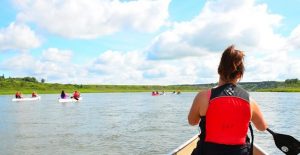
Back to Batoche Canoe Trip on the South Saskatchewan River, hosted by CUPE Saskatchewan Division. Photo credit: Arthur Rachul
Participants from across the province have launched canoes into the South Saskatchewan River today, embarking on a three-day voyage that will navigate more than 70 Kilometres of waterway by canoe and land at the Métis community of Batoche. Hosted by CUPE Saskatchewan and its Aboriginal Council Committee, the annual canoe trip has been held since 2003, as river conditions allow, and coincides with the Back to Batoche festival held at the historic site of the Battle of Batoche during the Northwest Resistance of 1885.
The union-led canoe trip seeks to build solidarity, promote cultural understanding and advance reconciliation as participants learn about the vibrant culture and traditions of the Métis, revisit the sites and history the Northwest Resistance, and travel the way of early bison hunters and fur traders to explore the waterway and surrounding lands that are the homeland to the Métis and Indigenous peoples within Treaty 6, including the Cree, Assiniboine and Saulteaux.
In 2010, CUPE Saskatchewan signed a landmark partnership agreement with Métis Nation Saskatchewan to promote greater participation and recognition of Métis peoples within the public sector workforce, to expand cross-cultural awareness and to increase cooperation in other public policy areas of mutual interest such as advocating for access to safe drinking water, educational opportunities and environmental stewardship.
Learn more about the 1885 Northwest Resistance through the Virtual Museum of Canada, published by the Gabriel Dumont Institute, available at the following link: www.virtualmuseum.ca/sgc-cms/expositions-exhibitions/batoche/html/about/index.php
For more information, contact: Nathan Markwart, CUPE Saskatchewan, at 306-757-1009.
/nm Cope342
The Voyage Back to Batoche. Navigating the South Saskatchewan River Through History.
Segment One: CLARKBORO FERRY CROSSING TO HAGUE
- Clarke’s Crossing. Clarke’s Crossing was named for Mr. and Mrs. John F. Clarke, who had established a ferry crossing at this point. The Dominion Telegraph Service established a telegraph station here in 1876. General Middleton’s troops arrived at Clarke’s Crossing in April 1885 to secure the ferry that Middleton assumed would have been taken by Louis Riel. Middleton spent five days at Clarke’s Crossing plotting strategy with his officers and by telegraph with the government. From this point, Middleton divided his troops and sent two columns to Batoche, one on the west side and his column on the east side of the river.
Segment Two: HAGUE TO GABRIEL’S CROSSING
- Middleton’s camp and the Fish Creek battlefield. This is where Dumont’s Métis forces first clashed with Middleton’s troops on April 24, 1885. On May 5, the Northcote steamship landed at Fish Creek with supplies for Middleton’s troops before heading onward to Batoche.
- Petite Ville. Further north of Fish Creek on the west side of the river is Petite Ville, the hivernement village founded in the late 1860’s where Métis families spent winters after the fall buffalo hunt.
- Gabriel’s Crossing. This is where Gabriel Dumont homesteaded and ran a ferry from 1877 to 1883. Métis author and activist Maria Campbell now lives here and helps operate the Gabriel Crossing Foundation, a First Nation arts school.
Segment Three: GABRIEL’S CROSSING TO BATOCHE
- Batoche. Now a National Historic Park, this is the historic community of the Métis people and site of the Northwest resistance of 1885. The town was originally called St. Antoine-de-Padoue, but was renamed after local merchant, Xavier Letendre, who was nicknamed “Batoche.” On both sides of the river at Batoche, the Métis had settled on long, narrow lots extending from the river. Running through Batoche was the Carlton Trail, which extended from Fort Garry (Winnipeg) to Fort Edmonton, and was the main overland route for the trade of fur and supplies in the west.
- River banks near Batoche. It was from both sides of the river that Métis and First Nations fighters fired upon the Northcote steamer as it approached Batoche. After the three days of fighting, many Métis women and children took refuge for two weeks in damp caves dug along the banks of the South Saskatchewan River to avoid being taken by the troops. Many became ill and died from pneumonia and starvation during this ordeal.
